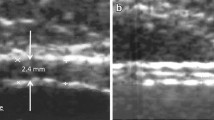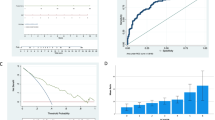Abstract
Purpose
To retrospectively assess the diagnostic predictive value of clinical characteristics to improve the diagnostic accuracy of bladder detrusor underactivity (DU) among benign prostatic hyperplasia/lower urinary tract symptoms (BPH/LUTS) patients who cannot undergo urodynamic examinations.
Methods
A total of 704 BPH/LUTS patients at Tianjin Medical Union Center from January 2013 through June 2016 were enrolled in the study. All cases were stratified by maximum detrusor pressure (Pdet.max) into two groups (DU and control). Patient and clinical variables were analyzed in both groups.
Results
One hundred twelve and 592 cases were classified into the DU and control group, respectively. PV (OR 0.976, 95% CI 0.961–0.991, P = 0.002) and PVR (OR 1.004, 95% CI 1.001–1.007, P = 0.004) were independent predictors of DU. In addition, Pdet.max was positively correlated with HTN (≥10 years) (r = 0.373, P = 0.001), smoking (r = 0.108, P = 0.039), IPSS (20–23) (r = 0.257, P = 0.013), PV (r = 0.305, P < 0.001), PSA (1–2.2 ng/mL) (r = 0.428, P = 0.002), PSAD (0–0.02) (r = 0.430, P = 0.02), and Q max (≤4 mL/s) (r = 0.372, P < 0.001), and inversely correlated with age (>76 years) (r = −0.265, P = 0.015), BMI (21–23) (r = −0.382, P = 0.001), DM (0–20 years) (r = 0.365, P = 0.009) and PVR (50–400 mL) (r = 0.423, P = 0.001). The AUCs for BMI, PV, tPSA, PSAD, Q max, and PVR were 0.762, 0.739, 0.727, 0.681, 0.749, and 0.716, respectively. Combined ROC analysis showed the AUC for PV + PVR was 0.774 with sensitivity of 77.78% and specificity of 73.68%.
Conclusion
Clinical factors were effective for predicting DU and could help improve the diagnostic accuracy for BPH/LUTS patients who cannot undergo urodynamic examinations.

Similar content being viewed by others
References
Patel ND, Parsons JK (2014) Epidemiology and etiology of benign prostatic hyperplasia and bladder outlet obstruction. Indian J Urol 30(2):170–176. doi:10.4103/0970-1591.126900
Oelke M, Bachmann A, Descazeaud A, Emberton M, Gravas S, Michel MC, N’Dow J, Nordling J, de la Rosette JJ (2013) EAU guidelines on the treatment and follow-up of non-neurogenic male lower urinary tract symptoms including benign prostatic obstruction. Eur Urol 64(1):118–140. doi:10.1016/j.eururo.2013.03.004
Osman NI, Chapple CR, Abrams P, Dmochowski R, Haab F, Nitti V, Koelbl H, van Kerrebroeck P, Wein AJ (2014) Detrusor underactivity and the underactive bladder: a new clinical entity? A review of current terminology, definitions, epidemiology, aetiology, and diagnosis. Eur Urol 65(2):389–398. doi:10.1016/j.eururo.2013.10.015
Abrams P, Cardozo L, Fall M, Griffiths D, Rosier P, Ulmsten U, van Kerrebroeck P, Victor A, Wein A (2002) The standardisation of terminology of lower urinary tract function: report from the Standardisation Sub-committee of the International Continence Society. Neurourol Urodyn 21(2):167–178
Seaman EK, Jacobs BZ, Blaivas JG, Kaplan SA (1994) Persistence or recurrence of symptoms after transurethral resection of the prostate: a urodynamic assessment. J Urol 152(3):935–937
Ahmed A, Farhan B, Vernez S, Ghoniem GM (2016) The challenges in the diagnosis of detrusor underactivity in clinical practice: a mini-review. Arab J Urol 14(3):223–227. doi:10.1016/j.aju.2016.06.005
Shaw C, Williams K, Assassa PR, Jackson C (2000) Patient satisfaction with urodynamics: a qualitative study. J Adv Nurs 32(6):1356–1363
Haylen BT, de Ridder D, Freeman RM, Swift SE, Berghmans B, Lee J, Monga A, Petri E, Rizk DE, Sand PK, Schaer GN (2010) An International Urogynecological Association (IUGA)/International Continence Society (ICS) joint report on the terminology for female pelvic floor dysfunction. Int Urogynecol J 21(1):5–26. doi:10.1007/s00192-009-0976-9
Powell CR (2016) Not all neurogenic bladders are the same: a proposal for a new neurogenic bladder classification system. Transl Androl Urol 5(1):12–21. doi:10.3978/j.issn.2223-4683.2016.01.02
Li X, Liao L (2016) Updates of underactive bladder: a review of the recent literature. Int Urol Nephrol 48(6):919–930. doi:10.1007/s11255-016-1251-x
Ameda K, Sullivan MP, Bae RJ, Yalla SV (1999) Urodynamic characterization of nonobstructive voiding dysfunction in symptomatic elderly men. J Urol 162(1):142–146. doi:10.1097/00005392-199907000-00035
Kullmann FA, Birder LA, Andersson KE (2015) Translational research and functional changes in voiding function in older adults. Clin Geriatr Med 31(4):535–548. doi:10.1016/j.cger.2015.06.001
de Barros CA, Lorenzetti F, Ortiz V, Dambros M (2013) Testosterone supplementation’s effects on age-related bladder remodeling—experimental study in rats. Aging Male 16(3):102–107. doi:10.3109/13685538.2013.807426
Kristal AR, Arnold KB, Schenk JM, Neuhouser ML, Weiss N, Goodman P, Antvelink CM, Penson DF, Thompson IM (2007) Race/ethnicity, obesity, health related behaviors and the risk of symptomatic benign prostatic hyperplasia: results from the prostate cancer prevention trial. J Urol 177(4):1395–1400. doi:10.1016/j.juro.2006.11.065 (quiz 1591)
Maserejian NN, Chen S, Chiu GR, Araujo AB, Kupelian V, Hall SA, McKinlay JB (2014) Treatment status and progression or regression of lower urinary tract symptoms in a general adult population sample. J Urol 191(1):107–113. doi:10.1016/j.juro.2013.07.005
Vignozzi L, Gacci M, Maggi M (2016) Lower urinary tract symptoms, benign prostatic hyperplasia and metabolic syndrome. Nat Rev Urol 13(2):108–119. doi:10.1038/nrurol.2015.301
Brown ET, Cohn JA, Kaufman MR, Dmochowski RR, Reynolds WS (2016) Phenotyping women with detrusor underactivity by presumed etiology: is it plausible? Neurourol Urodyn. doi:10.1002/nau.23079
Rastrelli G, Carter EL, Ahern T, Finn JD, Antonio L, O’Neill TW, Bartfai G, Casanueva FF, Forti G, Keevil B, Maggi M, Giwercman A, Han TS, Huhtaniemi IT, Kula K, Lean ME, Pendleton N, Punab M, Vanderschueren D, Wu FC (2015) Development of and recovery from secondary hypogonadism in aging men: prospective results from the EMAS. J Clin Endocrinol Metab 100(8):3172–3182. doi:10.1210/jc.2015-1571
Roberts RO, Jacobsen SJ, Rhodes T, Guess HA, Girman CJ, Panser LA, Chute CG, Oesterling JE, Lieber MM (1994) Cigarette smoking and prostatism: a biphasic association? Urology 43(6):797–801
Sarma AV, Jacobson DJ, St Sauver JL, Lieber MM, Girman CJ, Nehra A, Jacobsen SJ (2009) Smoking and acute urinary retention: the Olmsted County study of urinary symptoms and health status among men. Prostate 69(7):699–705. doi:10.1002/pros.20914
Tsuneki H, Nagata T, Fujita M, Kon K, Wu N, Takatsuki M, Yamaguchi K, Wada T, Nishijo H, Yanagisawa M, Sakurai T, Sasaoka T (2016) Nighttime administration of nicotine improves hepatic glucose metabolism via the hypothalamic orexin system in mice. Endocrinology 157(1):195–206. doi:10.1210/en.2015-1488
Rohrmann S, Smit E, Giovannucci E, Platz EA (2005) Association between markers of the metabolic syndrome and lower urinary tract symptoms in the Third National Health and Nutrition Examination Survey (NHANES III). Int J Obes 29(3):310–316. doi:10.1038/sj.ijo.0802881
Meigs JB, Mohr B, Barry MJ, Collins MM, McKinlay JB (2001) Risk factors for clinical benign prostatic hyperplasia in a community-based population of healthy aging men. J Clin Epidemiol 54(9):935–944
Bansal R, Agarwal MM, Modi M, Mandal AK, Singh SK (2011) Urodynamic profile of diabetic patients with lower urinary tract symptoms: association of diabetic cystopathy with autonomic and peripheral neuropathy. Urology 77(3):699–705. doi:10.1016/j.urology.2010.04.062
Nepomnyashchikh LM, Lushnikova EL, Neimark AI (2012) Remodeling of the muscle layer (detrusor muscle) of hyperactive bladder disease in patients with benign prostatic hyperplasia. Bull Exp Biol Med 153(5):778–783
Jiang YH, Lin VC, Liao CH, Kuo HC (2013) International Prostatic Symptom Score—voiding/storage subscore ratio in association with total prostatic volume and maximum flow rate is diagnostic of bladder outlet-related lower urinary tract dysfunction in men with lower urinary tract symptoms. PLoS ONE 8(3):e59176. doi:10.1371/journal.pone.0059176
Roehrborn CG, Boyle P, Bergner D, Gray T, Gittelman M, Shown T, Melman A, Bracken RB, deVere White R, Taylor A, Wang D, Waldstreicher J (1999) Serum prostate-specific antigen and prostate volume predict long-term changes in symptoms and flow rate: results of a four-year, randomized trial comparing finasteride versus placebo. PLESS Study Group. Urology 54(4):662–669
Djavan B, Fong YK, Harik M, Milani S, Reissigl A, Chaudry A, Anagnostou T, Bagheri F, Waldert M, Kreuzer S, Fajkovic H, Marberger M (2004) Longitudinal study of men with mild symptoms of bladder outlet obstruction treated with watchful waiting for four years. Urology 64(6):1144–1148. doi:10.1016/j.urology.2004.08.049
Idzenga T, Pel JJ, van Mastrigt R (2008) Accuracy of maximum flow rate for diagnosing bladder outlet obstruction can be estimated from the ICS nomogram. Neurourol Urodyn 27(1):97–98. doi:10.1002/nau.20480
Acknowledgements
The research reported in this publication was supported by Science and Technology Fund of Tianjin Provincial Commission of Health and Family Planning, Grant Number: 2015KR02.
Authors’ contribution
FL and JL were involved in project development, data analysis, manuscript writing. HHS, YHS, ZHZ, YSW, ZZ collected and analyzed data.
Author information
Authors and Affiliations
Corresponding author
Ethics declarations
Conflict of interest
The authors declare that they have no conflict of interest.
Human and animal rights
All procedures performed in studies involving human participants were in accordance with the ethical standards of the institutional and/or national research committee and with the 1964 Helsinki Declaration and its later amendments or comparable ethical standards.
Informed consent
For this type of study (retrospective), formal consent is not required.
Electronic supplementary material
Below is the link to the electronic supplementary material.
Rights and permissions
About this article
Cite this article
Luo, F., Sun, HH., Su, YH. et al. Assessment of noninvasive predictors of bladder detrusor underactivity in BPH/LUTs patients. Int Urol Nephrol 49, 787–792 (2017). https://doi.org/10.1007/s11255-017-1539-5
Received:
Accepted:
Published:
Issue Date:
DOI: https://doi.org/10.1007/s11255-017-1539-5




